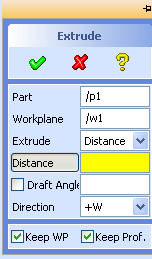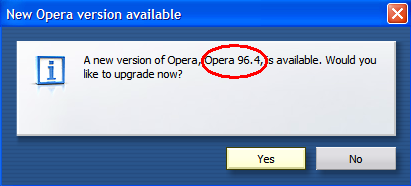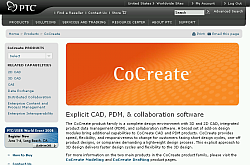And... Action! (Part 3, 19 Sep 2009)
 Let me explain.
In the 80s, our 2D CAD application ME10 (now: CoCreate Drafting)
had become extremely popular in the mechanical
engineering market. ME10's built-in macro language was a big success factor.
Users and CAD administrators counted on it to configure their local installations,
and partners wrote macro-based extensions to add new functionality - a software
ecosystem evolved.
A typical macro-language command looked like this:
Let me explain.
In the 80s, our 2D CAD application ME10 (now: CoCreate Drafting)
had become extremely popular in the mechanical
engineering market. ME10's built-in macro language was a big success factor.
Users and CAD administrators counted on it to configure their local installations,
and partners wrote macro-based extensions to add new functionality - a software
ecosystem evolved.
A typical macro-language command looked like this:
 Users didn't have to type in the full command, actually. They could start by typing in
Users didn't have to type in the full command, actually. They could start by typing in LINE
and hitting the ENTER key. The command would prompt for more input and provide hints in the
UI on what to do next, such as selecting the kind of line to be drawn, or picking points
in the 2D viewport (the drawing canvas). The example above also illustrates that commands
such as LINE RECTANGLE could loop, i.e. you could create an arbitrary amount of rectangles;
hence the need to explicitly END the command.
Essentially, each of the commands in ME10 was a domain-specific mini-language,
interpreted by a simple state machine.
The original architects of SolidDesigner (now known as CoCreate Modeling)
chose Lisp as the new extension and customization language, but they also wanted
to help users with migration to the new product. Note, however, how decidedly un-Lispy ME10's
macro language actually was:
- In Lisp, there is no way to enter just the first few parts of a "command"; users always have to provide all parameters of a function.
- Lisp functions don't prompt.
- Note the uncanny lack of parentheses in the macro example above.
- Define a special class of function symbols which represent commands
(example:
extrude). - Those special symbols are immediately evaluated anywhere
they appear in the input, i.e. it doesn't matter whether they appear inside
or outside of a form. This takes care of issue #3 above, as you no longer
have to enclose
extrudecommands in parentheses. - Evaluation for the special symbols means: Run the function code associated with the symbol. Just like in ME10, this function code (which we christened action routine) implements a state machine prompting for and processing user input. This addresses issues #1 and #2.
define-symbol-macro yet. And thus,
CoCreate Modeling's Lisp evaluator extensions were born.
To be continued...
Noch freie Kegeltermine! (19 Sep 2009)
Zu essen gab es in jenem Restaurant kroatisch-serbisch-italienisch-schwäbisches Crossover, und für Unterhaltung war auch gesorgt:
And... Action! (Part 2, 08 Sep 2009)
 No, we don't need contrived constructs like (print extrude) to show that
No, we don't need contrived constructs like (print extrude) to show that
extrude is somehow... different from all the other kids. All we need is a simple experiment.
First, enter extrude in
CoCreate Modeling's user input line: The Extrude dialog
unfolds in all its glory, and patiently awaits your input.
Now try the same with print: All you get is an uncooperative
"Lisp error: The variable PRINT is unbound". How disappointing.
But then, the behavior for print is expected, considering the usual
evaluation rules for Common Lisp,
particularly for symbols. As a quick reminder:
- If the symbol refers to a variable, the value of the variable is returned.
- If the symbol refers to a function and occurs in the first position of a list, the function is executed.
extrude & friends belong to the symbol jet-set in CoCreate Modeling. For them,
the usual evaluation rules for functions don't apply (pun intended).
Using symbol properties
as markers, they carry a backstage pass and can party anywhere.
For members of the extrude posse, it doesn't really matter if you use them as an
atom, in the first position of a list, or anywhere else: In all cases, the function which
they refer to will be executed right away - by virtue of an extension to the evaluator
which is unique to CoCreate Modeling's implementation of Common Lisp.
You can create such upper-class symbols yourself - using a macro called defaction.
This macro is also unique to CoCreate Modeling. Functions
defined by defaction are called, you guessed it, action routines.
But why, you ask, would I want such a feature, particularly if I know that it breaks with
established conventions for Lisp evaluation?
Well, precisely because this feature breaks with the established rules.
To be continued...
10 on Monday, 100 on Wednesday (02 Sep 2009)

Now, that's rapid development!
 PS: Yes, I know, this is old hat, but the message still gave me a good chuckle
PS: Yes, I know, this is old hat, but the message still gave me a good chuckle 
"This software will crash Real Soon Now™. Promise!" (02 Sep 2009)

 Fortunately, CoCreate Modeling has always had pretty elaborate crash handling mechanisms. Whenever an unexpected exception occurs, a top-level crash handler catches it, pops up a message describing the
problem, causes the current operation to be undone, restores the 3D model to a (hopefully) consistent
state, and returns the user to the interactive top-level loop so that s/he can save the
model before restarting.
Over time, we taught our crash handler to deal with more and more critical situations. (Catching stack overflows and multithreading scenarios are particularly tricky.) Hence, users rarely lose data in
CoCreate Modeling even if some piece of code crashes. Which pretty much obviates the need
for the proposed clairvoyance module.
Fortunately, CoCreate Modeling has always had pretty elaborate crash handling mechanisms. Whenever an unexpected exception occurs, a top-level crash handler catches it, pops up a message describing the
problem, causes the current operation to be undone, restores the 3D model to a (hopefully) consistent
state, and returns the user to the interactive top-level loop so that s/he can save the
model before restarting.
Over time, we taught our crash handler to deal with more and more critical situations. (Catching stack overflows and multithreading scenarios are particularly tricky.) Hence, users rarely lose data in
CoCreate Modeling even if some piece of code crashes. Which pretty much obviates the need
for the proposed clairvoyance module.
How to Detect Mergers & Acquisitions in Code (01 Sep 2009)


Previous month: Click here. Next month: Click here.
to top
Edit | Attach image or document | Printable version | Raw text | Refresh | More topic actions
Revisions: | r1.15 | > | r1.14 | > | r1.13 | Total page history | Backlinks
Revisions: | r1.15 | > | r1.14 | > | r1.13 | Total page history | Backlinks
 Blog
Blog